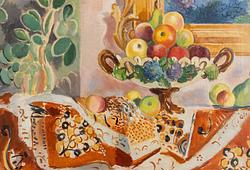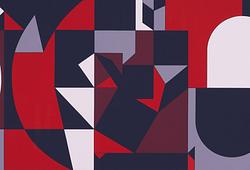Pär Axel Olsson
A tapestry, 'Näckens Bröllop' ('The Wedding of the Water Sprite / Nixie') flat weave, c 270 x 166 cm, signed PAO 19K&L06
Designed in 1905, woven in 1906 at Kulturens Konstslöjdsanstalt .
Alkuperä - Provenienssi
Stockholms Auktionsverk, Stockholm, 27 April, 2009, lot 256.
Acquired at the above auction by the present owner.
Kirjallisuus
Brunius, Jan, Swedish Textiles: 1890-1990, Signum, Lund, 1994, p. 94.
Lind, Kerstin, Textile Art Encounters: The Arts and Crafts School in Lund 1897–1932, Department of Culture and Society, Linköping University, Diss. Linköping: Linköping University, 2024, Linköping, 2024, image 60, p. 191.
Muut tiedot
The Swedish folk ballad tradition was a central source of inspiration for the Arts and Crafts Institute of Lund, and The Water Sprite’s Wedding stands as one of its most evocative textile compositions. The work is attributed to Pär Axel Olsson, assistant curator at the open-air museum Kulturen in Lund and later designer at the Institute during the 1910s and 1920s.
According to Kerstin Lind’s dissertation Textila konstmöten – Konstslöjdanstalten i Lund 1897–1932 (2024), the motif is preserved both as a working drawing and as a textile piece, all signed with Olsson’s monogram “PA” and dated. Another example of the same composition is held in the collection of the Nordic Museum in Stockholm, confirming the attribution.
In The Water Sprite’s Wedding, Olsson likely drew inspiration from the traditional ballad Necken och Jungfrun (“The Water Sprite and the Maiden”), in which the water spirit enchants a nobleman’s daughter. The scene depicts a chariot racing across a blue firmament, drawn by a black and a white horse—a dynamic interplay of light and shadow, love and enchantment. The darker figure at the reins is interpreted as the water sprite, while the fair-haired maiden in red represents the bewitched daughter.
The composition conveys movement and drama through the horses’ streaming manes and the fluttering garments, while hovering white and blue figures accompany the chariot across a dreamlike landscape. The Water Sprite’s Wedding embodies the Institute’s synthesis of national romantic narrative, symbolism, and masterful textile craftsmanship.
















































